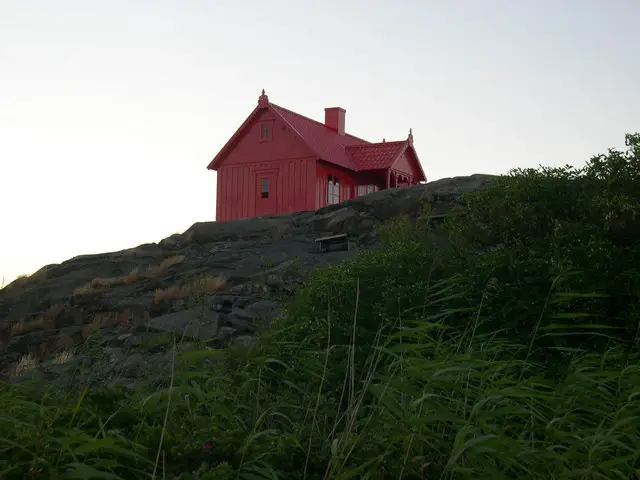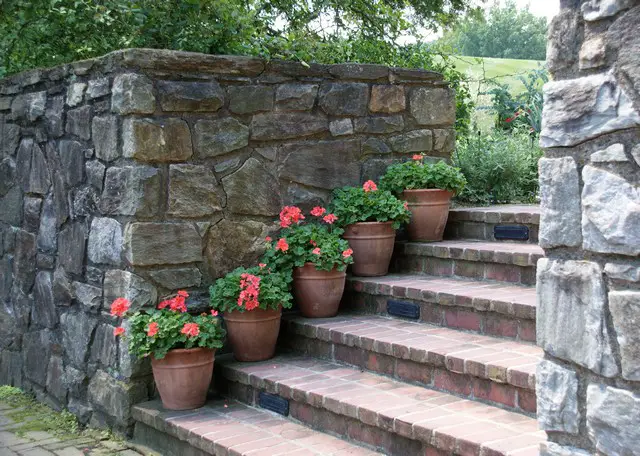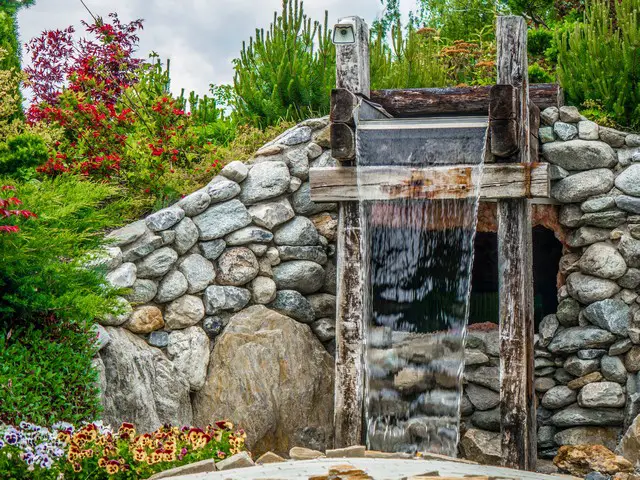Last Updated on June 15, 2023 by Grow with Bovees
Slightly sloping ground is an advantage, for it can make a garden more interesting than if it were perfectly flat.
Steep natural hillsides, however, as well as steep banks cut into the ground by the builder when levelling the site for the house, present a problem which involves thought, labor and, often, expensive construction.
Some architects, who fit the house on to the slope, make things easier for the new owner, who is not left with a steep bank after “cutting and filling”.
A steep bank, however, can be made to look attractive and there are several advantages in having one.
It can provide privacy and form a windbreak more quickly than trees.
Furthermore, trees planted and grown on top of it can shut out any undesirable view.
A south-facing slope is warmer than a flat garden which is exposed to wind and you can grow many tender plants against it that could not normally not be grown in that particular spot.
Nevertheless, every slope creates a problem and you need to use your imagination in order to make the most of it.
There are many ways of treating sloping ground, depending on whether the garden is large or small or whether the slope is slight or steep.
Whatever the slope, try to make a level area of at least 20-feet in front of the house, so that it can be seen at its best.

How To Stop Erosion on a Sloped Yard
The key to stopping erosion on a sloped yard is to recognize what causes it in the first place. While there are a number of factors that can cause water to wash away soil, many of them boil down to one thing: gravity.
The sloped yard has several advantages for the gardener, but erosion is not one of them. Fortunately, there are several ways you can keep your yard looking great, and keep the soil from washing away.
If You Have A Gentle Slope
A shallow slope can be turned into a series of two or three level areas, irregular in size, with low banks between, or can be levelled into one large area with one steeper bank, preferably near the back.
The entire garden can be allowed to form a gentle grassy slope, but you need to break it here and there with small level areas and features like low retaining walls, or you will have an uncomfortable feeling of being unable to linger and rest in such a garden.
This can be done quite informally by using several methods.
Build a semi-circular low slate wall into any portion, levelling out the area in front, possibly for a bench, and use it as a focal point for planting overhanging plants at the top of the wall.

Scoop out a bay anywhere down the slope and group a mass of rounded or rambling shrubs on the flattened portion, allowing some to tumble down from the top, like Honeysuckle or Plumbago, as well as a few creepers.
The sides of this bay of shrubs will merge into the grassy slope.
Small rock outcrops can be fitted into parts of the slope and planted with colorful flowers or spreading shrubs.
A gentle slope is ideal for a narrow stream trickling down the side to fill a pond near the bottom, or even a series of rocky pools, planted with water loving plants. If you do this, don’t forget the water supply!
Instead of walking up the grassy slope, you can put down a ramp-like path which consists of long, shallow steps.
These can be made of blocks of brick. Each block can be edged with a strip of Ajuga (Carpet Bugle) and the next step can be put down a little higher than the last.
Your path can also be made of slate, just make sure to break it with plants and arrange the next level like a step, as a continuous ramp is tiring and can be dangerous.
If You Have A Medium Slope
This should be divided into a series of levels held by low retaining walls, rockeries and other methods.
Change the level in parts rather than cut the ground into large, level, equal areas.

A medium slope can be treated in some parts like a shallow slope and in some parts like a steep slope.
If you are forced to level the whole area, then make two steeper banks, one behind the house and one in front.
Plant shrubs and trees on top of the banks as a windbreak.
If You Have A Steep Slope
This must be controlled in order to prevent soil erosion.
You can cut and fill to obtain some large level areas.

Leave the natural slope on other parts and pack the ground with shrubs and groundcovers.
Hold the banks between levels in different ways described below. Build in curving paths or ramps between levels.
Avoid formal square terraces built like a series of giant steps going down a steep hillside.
Rather have one broad terrace, then a series of two or three smaller terraces of different sizes, or even a steep bank held by a rockery.
Try to curve retaining walls in order to avoid a stiff appearance. If the wind is a problem, plant small trees at the top of each level.
For a steep slope in a small garden, make numerous small terraces which can be treated as flower beds.
Cover the low retaining walls with overhanging plants. Try to vary the size of the terraced beds and do not make them too straight.
You will need some narrow winding paths between the terraces in order to tend to the flowers.
How To Landscape a Hill
A long high bank can be treated differently in sections, provided that the total effect is harmonious.
You can move the soil, and any rocks, with the aid of machinery if necessary, so that parts of it are made broader and shallower than others.
The steeper parts can be held by means of walls or rockeries, while the more gradual slopes can be held by plants or grass.
You can divide a bank into two or three level terraces, at least 6 feet (1.83 m) wide, and plant them thickly with shrubs and creeping plants to overhang the retaining walls.
This will give the effect of a bank of greenery. Once you have walls and rock to check erosion, you can plant almost anything on a bank, but if there is no hard material to hold the soil, it is possible to knit the soil with the roots and creeping stems of suitable plants, such as creeping Jenny.

How To Hold the Soil on a Slope
Rockeries
- A rockery is the most natural and appealing way to hold the soil on any slope, steep or gentle, and there are many plants suited to a rock garden.
- Try not to overdo them, however, and reserve them for one bank only if possible.
- Try to treat other banks in one of the ways described below.
- Rockeries can be used in conjunction with grass and other plants, as well as steps and waterfalls.
- Use a geotextile fabric under the rockery, this will help to retain the rocks, and also act as a weed barrier, helping to prevent weed germination within the rockery.
Plant Grass
- Grass has long been used to hold banks in the form of rolling lawn.
- This is most satisfactory on a gentle slope for there are difficulties with mowing, watering and feeding grass on a steep slope.
- If lawns are planted to intersperse rockeries, there is the added labor of trimming, and applying weed and feed etc., of the grass near the rocks.
- Make use of ground-covers which will hold the soil as well as the lawn, but require no clipping.
Construction
- A certain amount of construction can be done to give interest to a bank.
- Changes in level can be finished off in many ways.
- Retaining walls of many kinds, fencing and steps can be used on their own or in conjunction in order to hold the soil on a bank.
Retaining Walls
- A low wall can be built at the foot of a slope to give the effect of a raised bed.
- This gives a neatly finished look to a garden and can be overhung with many delightful plants.
- Always try to curve the wall like the edge of a herbaceous border and use decorative materials like stone, slate or old brick.
- The low wall can take the form of a long garden seat, topped with wood if liked.
- Such a bench can also be built with a back made of stone to take care of a 3-foot drop.
- The soil at the top can be sloped back or it can be edged with plants like a window-box.
- Medium Height Retaining Walls
- These can take the form of a double wall or a dry wall, which permits free drainage.
- High Retaining Walls
- These are often hard-looking, but can be softened by planting large creepers like Golden Shower, wild grape vines, or morning glory (just be sure to control it!), at the top and allowing them to curtain the wall.
- High walls can be made more interesting by building them in the form of long window-boxes or double walls for growing plants up the wall. This is worth doing if the garden area is small, as it gives you more space to grow plants.
- Build Some Steps
- Steps make changes of level interesting and can be formal or informal. Steps always lead to problems of how to retain the soil at the side.
- Informal steps are best edged with rocks.
- Formal steps should be edged with low walls over which plants can be grown to soften the edges.
- Long steps can be made along the whole length of a bank and covered with grass, but are laborious to maintain.
- Long steps made of materials like slate or brick can be broken by informal planting.
- Construct all the risers along the bank, but only fill in the treads in two or three places, leaving the rest open in large portions.
- Fill these in with a mixture of plants like tall rounded Daisy Bushes or spreading plants like Senecio leucostachys or Gazanias, as well as graceful plants like Agapanthus.
- Build A Fence
- A fence of stout planks can be used to hold up the base of the bank and overgrown with climbing roses.

Dense Planting.
Your aim here should be to plant broad-leaved evergreen shrubs and spreading groundcovers in sweeping masses following the contour of the bank to create a mass of luxuriant greenery.
This can be very effective on a hillside. It can be done on a low bank as well.
Dense planting is most successful if the ground slopes back at an angle of at least 45 degrees or preferably 30 degrees.
Try not to over plant with too much of a mixture or you will end up with a jungle later.
Choose shrubs which are not too rampant or there will be too much pruning afterwards. Spreading plants are excellent, but you need to know how much space they ultimately require.
You can plant slow-growing shrubs and fill the spaces between them with numerous, easy-to-propagate plants which can be pulled out alternately as the shrubs mature.

A few high-headed trees will relieve the planting and provide privacy. These can be under-planted with shade-loving shrubs edged with low evergreens.
Choose plants that do not need coddling and will stand up to possible droughts.
Wild plants, succulents and drought-resistant plants like Plumbago are suitable.
How to Plant On A Slope
Make contour furrows up the slope and plant out thickly for quick effect.
Covering the ground closely, especially with groundcovers, prevents weed growth and erosion. Do not take cuttings of Ivies or Mesembs, and plant them directly into the slope, but start them in trays so that they can develop strong roots first.
Plants like Nierembergia or Wild Strawberry (Duchesnea) are also best started in flats.
If plants are given a good start they will survive and grow more quickly in a difficult situation.
Evergreen shrubs should be transplanted into position once they have a good root ball.
Cut back into the soil on the slope and pack the soil in front to make a basin, holding it with a rock if required.
Place the plant in the center and apply water slowly. On a steep slope insert a hollow pipe leading from the surface towards the roots and water through it.
Plant heavy shrubs near the base of the bank to hold any slipping soil.
Introduce a few bursts of colorful annuals like Petunias or dwarf Marigolds to relieve the density of foliage.
This is especially important in a small garden. The tops may be cut back at the end of the season, leaving the roots below to knit the soil, as well as manually aerate and feed it when decaying.
Water the bank by saturating it with a fine spray from a sprinkler nozzle.
Careful attention to weeding and watering, as well as filling in soil that may have eroded, is important in the first year.
Once the planting is established, it will require little further care. A trellis of rope or nylon with large holes, or erosion control blankets will hold the soil until your plants grow on steep slopes.

